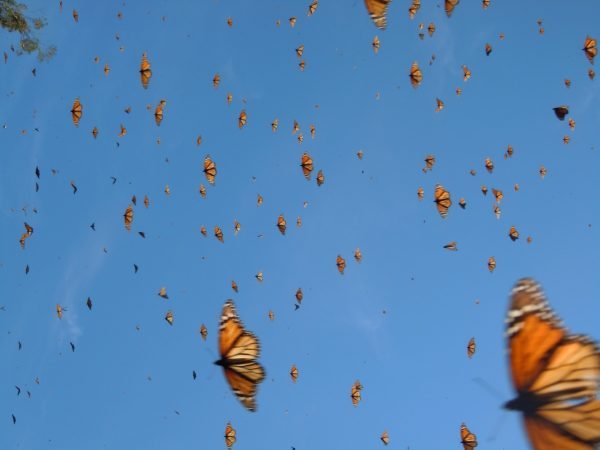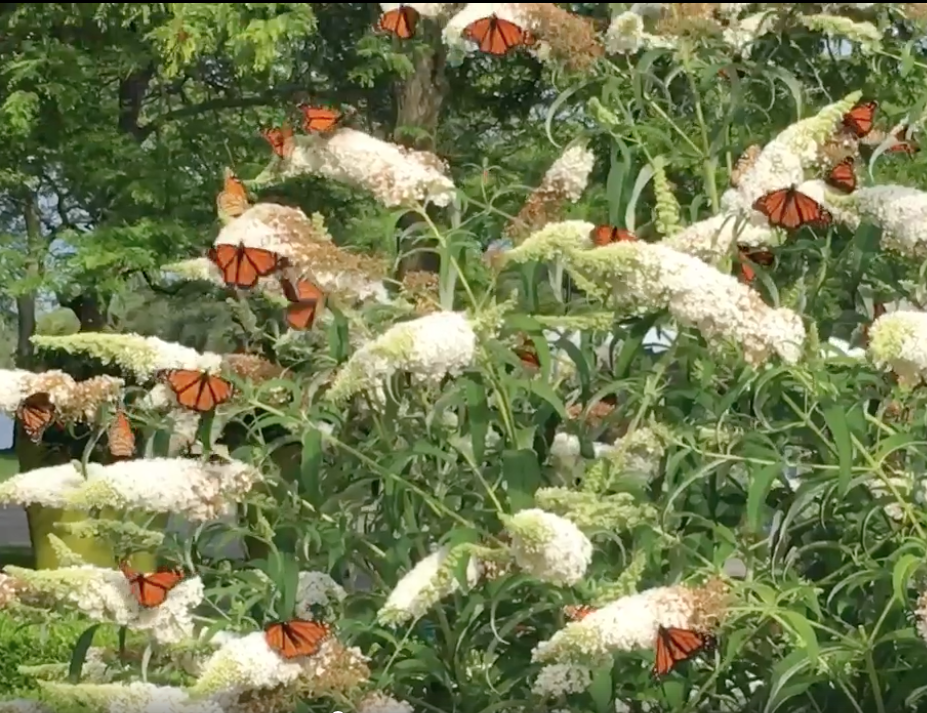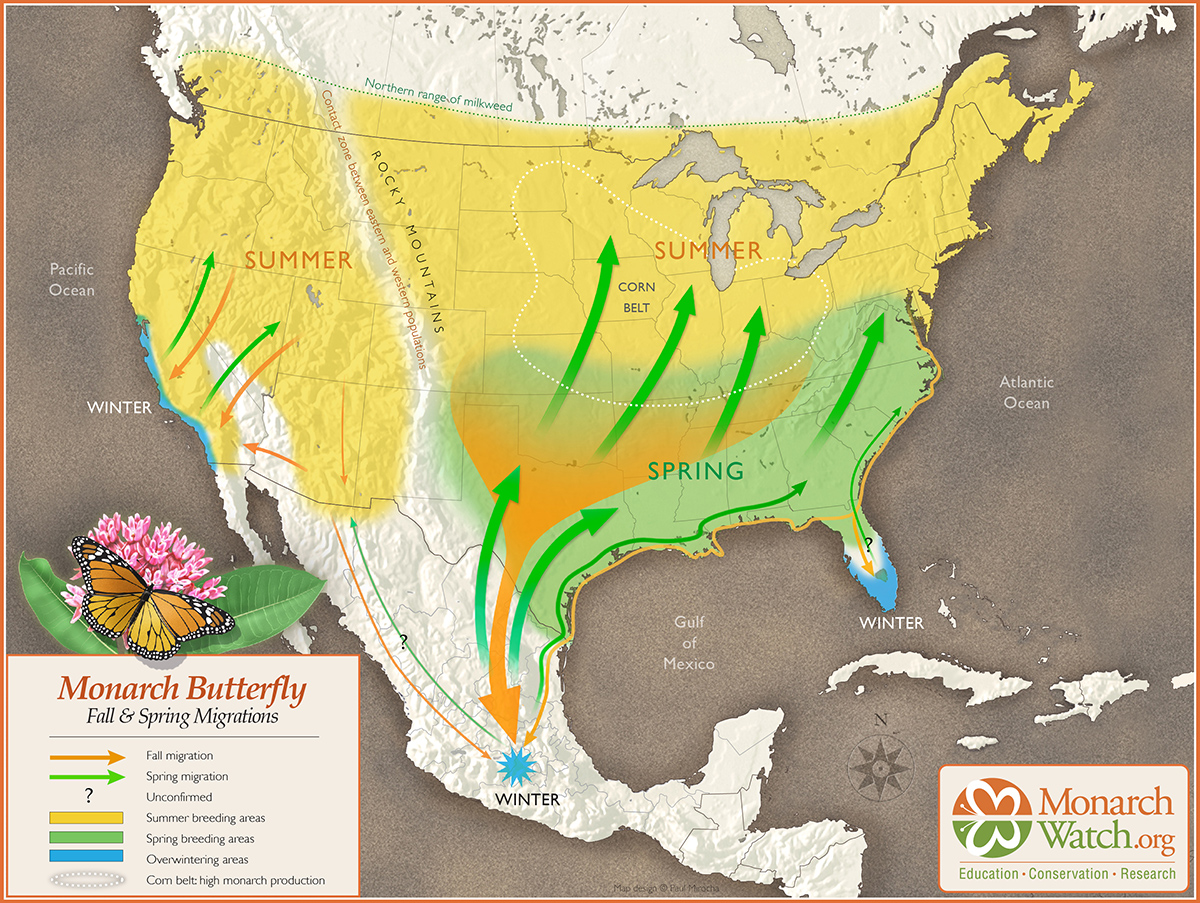SAN ANTONIO — Monarch butterflies have begun their southbound migration in what could be a banner year. The iconic black and orange butterflies will start arriving here in the coming weeks, with peak migration for our latitude slated for October 10 – 22, just in time for our fourth annual Monarch Butterfly and Pollinator Festival.
Recent reports from Canada and Maine, the northernmost reaches of the monarch migration, have touted large numbers of the charismatic insects.
“This morning on Toronto Island, more monarchs than I’ve seen yet,” Jackie Robson posted on September 2 in the niche Facebook group, Monarchs Migrating through Ontario. “Hundreds and hundreds very quietly nectaring on Buddleia and Joe Pye (weed).” Click on the video below to experience what Robson labeled your “30 seconds of Zen.”
“This year’s large numbers are a hopeful sign, and the migration is continuing to pick up steam,” Journey North, a citizen science initiative that tracks migrations of the monarch and other wildlife, reported in its weekly update September 5. The organization also noted almost 150 overnight roosts were reported by citizen scientist volunteers. In the evenings, monarchs drop from the sky and rest in trees for the night, often along streams and rivers with nectar sources nearby. For more insights, check out Journey North’s live monarch migration tracking map.
An August 29 article in the Bangor Daily News touted a farm “enveloped” by monarch butterfly chrysalises about 60 miles south of the state’s capitol. “There must be thousands,” Heather Halsey told the reporter, as jade green, gold-flecked monarch chrysalises dangled from the window frames and wood siding of a building. The chrysalises typically hatch into butterflies within 10 days.
Caution tempers the good news, however. Much can happen between now and the time the butterflies arrive at their destination in Mexico, about two months from now. Myriad hazards could derail what appears to be a banner year–wildfires, hurricanes, a lack of nectar in the Texas Funnel and northern Mexico, aerial spraying of pesticides, among the concerns.
“I’m not ready for an update,” said Chip Taylor, founder of Monarch Watch, the citizen science tagging organization that tracks migrating monarchs each fall, when asked for a prediction. “I’m looking at the roost counts, the temperatures, the accounts of larvae, the accounts of many and the accounts of few, watching the rains in Texas.” Taylor deferred questions to a Monarch Watch blog post he wrote August 1 in which he stated that prospects for a “reasonably robust population look quite good.”
Here in the Texas Funnel, the migratory corridor through which all migrating monarchs must pass on their way to Mexico, widespread drought has been interupted with spotty, occasional thunderstorms all summer. The Texas Funnel is critical to the migrating insects in the later stages of their migration since here is where they fuel up and build the fat stores that will get them through the winter in Mexico. A lack of nectar sources can be devastating.
At our family’s Llano River ranch last weekend, goldenrod bloomed prolifically. Bees, wasps and several Queen butterflies nectared on their abundant yellow blooms, and monarch and Queen eggs dressed the Swamp milkweed, Asclepias incarnata, that lines the Llano River banks.
That was not the case 30 miles away in Menard, where Jenny Singleton, a longtime docent for the Grapevine Flutterby Festival, has been tagging monarchs for decades at her family’s ranch along the San Saba River. In late August, Singleton texted me after a visit to her place. “It’s scary how hot and dry it is here. No nectar plants except for a few lantanas…I’m worried about the migration.”
In Comfort, just outside San Antonio, Cathy Downs, an outreach specialist for Monarch Watch who often hosts educational workshops on the insects, also expressed concern. “We haven’t had any rain here since June. It’s really crispy. No nectar. I’m hearing good things about the outlying areas getting rain. But not here.” Downs had spent much of the summer in Maine, and said “caterpillars were everywhere!”

Caterpillar eggs on Swamp milkweed on the LlAno River last weekend. Photo by Monika Maeckle
All those chrysalises in Maine will soon hatch, and those monarchs will be heading south. An abundance of caterpillars and chrysalises suggest we are in for a late, possibly great migration.
Related posts:
- Monarch expert Dara Satterfield to appear at Butterflies without Borders Forum
- Butterflies without Borders: Monarch Butterfly and Pollinator Festival to take flight Oct. 12 – 20
- San Antonio’s 300for300pollinator habitat initiative expands to 500 by 2020
- Popularity of pollinator gardens growing in areas prone to drought
- Planting a butterfly garden? Here’s tips on how to do it
- Mostly native butterfly garden outperforms lawn every time
- A year in the life of an urban butterfly garden
- Downtown River walk plot converts to pollinator garden, creature haven
- Converting your Lawn to a Butterfly Garden
- San Antonio becomes first National Wildlife Federation Monarch Champion city
Like what you’re reading? Don’t miss a single post from the Texas Butterfly Ranch. Sign up for email delivery, like us on Facebook, or follow us on Twitter, @monikam.




Is the field observation support for the notion that “a lack of early fall nectar sources in Texas can be devastating to the migration?” During the ultra severe 2011 Texas drought I drove hundreds of miles between Del Rio, Texas and western Oklahoma during the time the fall migration was passing through and I didn’t see any signs the monarchs were desperate for nectar or water. A couple examples from Del Rio, Texas: https://youtu.be/bO-b1JwDVUM https://youtu.be/rTpbzu9B1G0
“With a little good fortune weather wise, conditions point to another substantial increase in the migration numbers again this year. More returning monarchs from Mexico than ever before have been posted on the Journey North Maps. The weather in the Midwest is predicted to be normal and average temperatures and precipitation. Common milkweed shoots naturally sent out during the record precipitation in the summer breeding grounds and common milkweed planted last season will flourish and at least “double” the stems on the landscape in the monarchs most productive areas in the Midwest and Northeast during the migration.”
I can’t remember exactly when and what I said back in May although based on the weather predictions I thought we would have 10-12 hectares overwinter 2019-20 and with a little rain throughout the Texas monarch “migration funnel” I’m sticking to it. Maybe you can remind me when I posted that Monika
Will the migration be affected by the wildlife preserve and monarch butterfly Ranch on the Texas border that Trump had bulldozed for his stupid wall?
I’m sure glad to hear that monarchs numbers are up. I’m looking forward to seeing them pass through😎.
I was just wondering about the monarchs laying eggs on the milkweed in Llano River area. I was under impression that as the 4th gens make their ways southerly to Mexico they won’t mate until spring when they start to head north again. What generation is laying eggs?
I captive reared 60 this year, we live in the adirondacks…now officially down to 4 chrysalisses and 2 freshly eclosed monarchs. It’s been a phenomenal year here at our way station. Wish now we’d tagged some of them this season but decided not to.
5th generation WHAT WE KNOW U S Fish and Wildlife https://fws.rev.vbrick.com/#/videos/2f035e5f-483b-429c-ac31-6f670f4a2cbb
A very small percentage of the female monarchs headed south to the overwintering sites in Mexico get pregnant during the journey and drop out of the migration to look for milkweed to lay their eggs on. Another small percentage that arrive at the overwintering sites during the late fall get pregnant and fly down to the valleys beneath the overwintering sites to look for milkweed to lay their eggs on.
i was wondering since monarchs don’t recognize borders why Dara Saterfield hasn’t gone into Mexico and studied monarchs all the way to the wintering sights in the lowlands. . They ignored the Florida population in her study where tropical is everywhere year around and 2 out of 3 monarchs are heavily covered with OE and the population still thrives. I was hoping someone will ask about that at the San Antonio Festival next month. ?? I’ve already made the decision makers at FWS aware of this. Do you have any studies that were done on the lowland monarchs? Did Bill Calvert do any ?
I am looking for information on the winter habits of Monarchs in Mexico, feeding during the winter months, preferred nectar sources near their overwintering sites in the Reserve, feeding habits prior to arrival at these sites and upon departure. Can anyone help?
I have seen more Monarch butterflies in my home gardens and at our small farm located on Outer Cape Cod (Orleans, MA), laying eggs on milkweed this summer, than I have seen in years. I have seen leaves with 6 eggs all on one leaf. Finally the last of the 6 caterpillars I was observing last week on some potted non-native annual milkweed (“Silky Red”) we grow and sell, appear to have crawled off to hang. The plants are next to our greenhouse so some crawled inside (sides rolled up) to form chrysalis’s. I have now found 3 plus the remnants of 2 which already emerged. One of the three is darkening now. Thankfully it will probably not emerge until tomorrow after the effects of Hurricane Dorian are well past. I also have one in my house that an employee found attached to a pile of bamboo stakes that had fallen over. I repositioned the bamboo so it hangs properly and check it daily. Last month, I relocated 18 caterpillars to a larger stand of native milkweed at our farm as there were too many foraging voraciously on the ones in pots, and they had already eaten most of the leaves. There was not enough left for them to eat and continue to grow. I just hope these late emergents make it south before the frosts start. We usually don’t see a frost here until November, but that is because the ocean keeps us warmer in the fall. However not far away, even to our south, colder weather will occur. Fingers and toes crossed with hope for this wonderful species!
This the second large batch of Monarchs I’ve had here this fall. The first batch which was on time came through here on Labor Day and left on the 2nd of September. The second batch arrived here on the night of the 5th of September. This is very unusual because I never have add two batches over stay the night here in the fall migration. And let alone this late. They’re not quite as a large has they are normally. Three years ago when they left they covered up path about a half mile wide and a mile and a half long. now that’s the most intensive I’ve ever seen. Last year their numbers were down quite a bit. From what I see this kind of looks like a normal size migration but like I said it’s kind of different that they’ve came into groups. And I don’t know if we’ll get anymore but I’ll have to watch I’m sure when the wind switches to the Northwest these will leave and then the next cold front of probably bring another batch maybe?
Thanks for this awesome article regarding the migration of monarch butterflies. It’s so interesting to learn how different species move throughout the nation. Keep up the good work!
This morning I have a brand new Monarch asleep here at 8,000 feet. There are no flowers for it so what should I do? I tried to make a bit of sugar water for it but it was not interested. Something ate our entire milk weed this year so there is nothing left but stalks.
I read reports about the large increases in Monarch populations and other butterflies from 2020 to 2021. Completely anecdotal observation, but in 2020, vehicle traffic was dramatically reduced the entire year. Living in Driftwood, TX, I can tell you that you can hit butterflies with your car frequently and often unavoidably. That one factor alone had to substantially contribute to millions of butterflies surviving the entire migration cycle from Mexico and back again in 2021. As people move into the suburbs and things normalize, this can go the other way because traffic in more suburban and rural areas will increase hazards to butterflies and other flying insects.